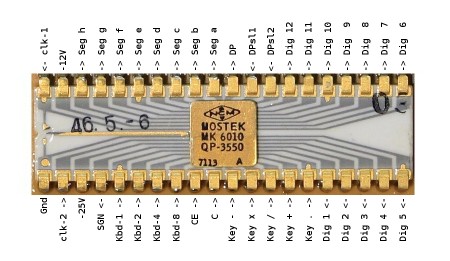"The winner hit the line..."

The pinout
The IC is supplied with to voltages: -12V and -25V to ground. Two phase clock clk-1 and clk-2 runs with 20kcs and has a voltage swing from 0 to -25V. Many of the old microprocessors needed multiphase clocks, which had a higher level than the rest of the logic. One of the last of them was the Z8002, who had a +12V clock.
In opposition to later single chip calculators, where keys were connected in a matrix, every key at the MK 6010 has it's own pin. Active levels are -12V static. Only the digit keys go through a diode encoder, so they need only four pins, (8-4-2-1-coding, 0 is represented by 1010). Probably for debouncing of the keyboard, eventually for protection of inputs from statical discharge, all inputs have RC-low pass combinations. The selector switch for the decimal point goes to the inputs DPsl1 and DPsl2. The four selectable comma positions are fix encoded.
All outputs on the pcb have a level between 0 and -1.25V. Because the MK 6010 is too precious to compromise it by experimenting, we can only assume that it are "open drain", i. e. switched current outputs and that the voltage swing at the outputs is determined by the inputs of the display drivers. The single display positions are activated by the outputs Dig 1 (LSB) to Dig 12, the 8 segments of the vacuum fluorescent displays are controlled by outputs Seg a to Seg h. Decimalpoint DP is only connected to the six lower positions, the sign is indicated by a neon bulb.
Suppression of leading zeros isn't done by switching off the segments, it is done by suppressing of the respective digit pulses.
